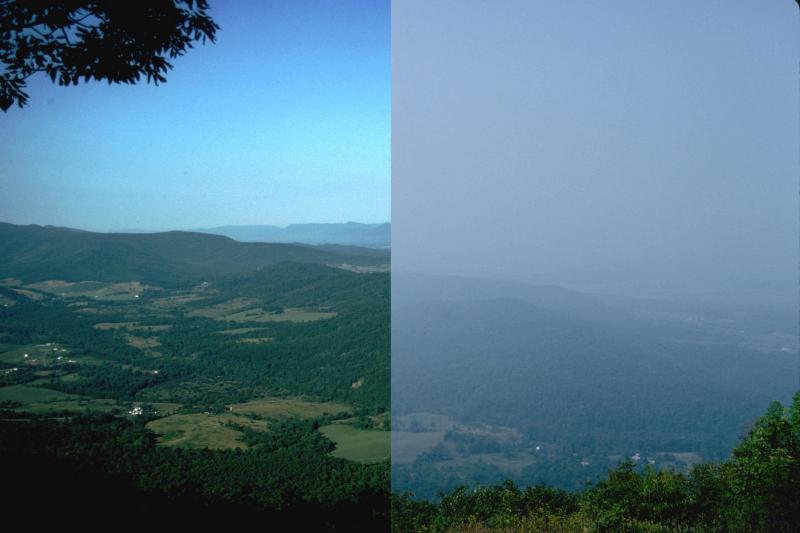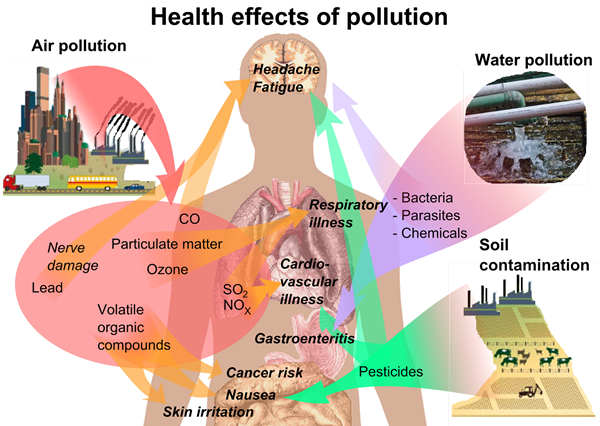Fifty years ago, Washington’s Clean Air Act was adopted to improve air quality for Washingtonians. Since that time, much has been done to reduce harmful pollutants that effect the environment and people’s health.
One of the many benefits of the good work started years ago, if maintained, is that that you, and future generations, can enjoy the state's majestic mountain wilderness areas.
Seeing clearly through the haze
If you’ve ever looked out at Mt. Rainier, or any other scenic vista, from far away and it appears hazy or blurry, chances are those aren’t clouds blocking your view. It’s likely air pollution, also referred to as regional haze, and it’s one of the many air quality issues we’ve been working to improve. The same view with different amounts of particulate matter in the air.
Regional haze is formed by particulate matter that absorbs and scatters light. It can travel a very long distance and individual particles are too small to see with your eyes. The more particles in the air, the harder it is to see far away. It also can cause serious health problems when inhaled.
What makes up air pollution?
Air pollution and smoke are made up of hundreds of different complex mixtures of gases and fine particles, like soot, dust, and dirt.
Many of these mixtures contain harmful primary pollutants such as:
- Sulfur dioxides — Gases that form when sulfur is exposed to oxygen at high temperatures during fossil fuel combustion, volcanic eruptions, oil refining, or metal smelting. At high concentrations it can dissolve in clouds and chemically combine with oxygen to form sulfuric acid, otherwise known as acid rain.
- Nitrogen oxides — A group of gases composed of nitrogen and oxygen. Two of the most common nitrogen oxides are nitric oxide and nitrogen dioxide. Nitrous oxide is a greenhouse gas that contributes to climate change. Nitrogen oxides are produced by the burning of fuels from many things such as vehicles, power plants, industrial, commercial and manufacturing facilities.
- Volatile organic compounds — These are chemicals that can easily become vapors or gases. Along with carbon, they contain elements such as hydrogen, oxygen, fluorine, chlorine, bromine, sulfur, or nitrogen. Gasoline-burning engines are a major source but they are also found in many products used daily, such as paint and household cleaners.
When nitrogen oxides and volatile organic compounds interact in sunlight, they create ground-level ozone, a secondary pollutant. Ground-level ozone is a harmful, colorless, and highly irritating gas that forms just above the Earth's surface. This is not the same as stratospheric ozone in the upper atmosphere that protects us from the sun’s ultraviolet rays.
Effects of pollutants on the environment
Even though many of these compounds are found in nature, having too many of them can:
- Make lakes and streams acidic; harming aquatic life and economically damage fishing industries.
- Change nutrient balances in water and soil, causing damage that can’t be repaired.
- Cause damage to forests, resulting in a loss of wildlife habitat.
- Damage crops, resulting in economic loss.
- Contribute to acid rain, that stains and erodes monuments.
- Affect the diversity of ecosystems, by limiting their ability to function and grow, such as during oxygen-robbing algal blooms.
Effect of pollutants on human health
Air pollutants, like fine particles and ozone, can harm people’s health. As pollution levels rise, the number of trips to the doctor due to pollution-related illnesses may also increase. Air pollution is a real public health concern because it can cause or contribute to serious health problems like:
- Headaches.
- Premature death in people with heart or lung disease.
- Heart attacks.
- Irregular heartbeat.
- Aggravated asthma symptoms.
- Decreased lung function.
- Irritation of the eyes and airways causing coughing or difficulty breathing.
- Respiratory infections.
- Cancer.
- Increased health care costs.
People at the most risk are children, pregnant women, the elderly, and those with cardiovascular or respiratory disease. Health effect research shows that death rates in several U.S. cities increased when there were higher levels of particulate matter in the air.
Coming soon
Our third and final blog will discuss things you can do to minimize your contribution to air pollution and what Ecology is doing to protect human health and the environment. Working together, we can ensure healthy air for another 50 years and future generations!
If you’re interested in seeing what the air quality is like in your community, check out the monitors in your area by visiting Washington’s Air Monitoring Network.




